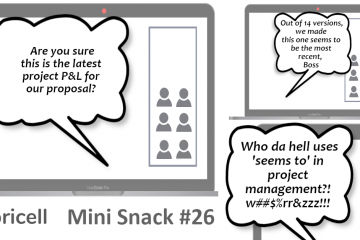
Price Range is not a Range Anymore
The road from estimating work for the scope to approved and presentable price is a long one.
A company living on delivering projects does this thousand of times and masters the process to get it efficient as it can be.
But often there are some risky moments, which makes it harder.
“Give me a range of price. Please.”
Then very soon the bottom number of that range is the one that only matters in a discussion.
Sounds familiar?
We all have been in this situation thousands of times.
This could be just sharing estimates internally with management or sales. Or could be providing a number to customer unofficially, or officially as RFI or RFP.
What smart Project Manager or person responsible for preparing project P&L does? He/She will not provide range but communicate upper number.
It works well for managing expectations. But nothing comes without its price. The trap here is everybody builds up buffers to protect himself. The final product – the price, maybe unsalable or at least hard to sell.
Here are the top 4 moments to watch when estimating and pricing.
Workload Estimations
When estimating workload most common approach is to ask an expert on task duration and workload. We are before touching the cost or price yet.
The experts' answer we receive is safe and conservative.
Nothing against experts here. It is just human nature we provide 'safe' information.
This is not a point here.
"The real problem is that if we add contingency on the task level. It is almost given we will deliver the task as planned with contingency.
Very few people will remember where it was added later when executing."
But when we play a safe estimate, we already adding some of the buffers to duration.
Quite often numbers from experts are additionally rounded up by the project manager to be on the safe side. It affects time but later cost calculation as well.
Many project managers add contingency into task duration and workload. They do this on purpose, but not in a transparent way.
The fact that in the end, we have a bit more unnecessary “fat” in the estimations is not a full issue.
The real problem is that if we add contingency on the task level.
It is almost given we will deliver the task as a planned plus contingency. Very few people will remember where it was added later when executing. They will guide delivery based on task workload - of course with contingency.
Our contingency becomes a cost at the moment of definition.
Official Risk Buffer
If a company have strict rules on how to define risk buffer that there are two ways how this can be realized:
- Risks in task and workload
- Risk Budget
The first method is not much different from that workload estimation described above, but it is transparent. The risk that contingency will be used is still high.
The second method is to define a budgetary risk buffer and keep it as a separate position.
I am a strong advocate of this method.
But what's a risky moment here? There are a few.
First, we have to have a firm method to calculate it, otherwise, the risk budget is constantly under attack from those who want to have a price lower and challenge our total cost calculation.
Their story is simple. We need to deliver w/o risk buffer. I am in a competitive situation and don't need any buffers on top. Manage it professionally enough we don't need risk buffer at all.
If our risk buffer is not supported by the solid method, we are exposing ourselves to pressure. If we fail to convince, we defined risk buffer properly, we will come back to workload estimation hidden contingency method next time to avoid a discussion.
The second issue is we need to have good risk buffer management during project execution. Many companies don’t have it.
If we don’t have it or is not transparent, we either will consume risk buffer and not notice it or we will keep having risk buffer not used, and sales next time will put even more pressure on us.
Cost Rates Misuse
Another moment is to use the right resources for the job and the right cost rates for the job.
Those two are not too obvious they go together.
We can easily calculate costs based on resources that are not available.
I have seen many calculations based on offshore resources, but when came to execution it turn out offshore can not be allowed due to security reasons.
Was this known at the moment of calculating cost? Possibly.
Delivering the roles by people who have a more expensive cost rate is a common problem in project execution.
Sometimes this is an art to come up with the right information. Often it is a long preparation based on the history of cooperation with the customer, or knowing how procurement works at this customer. Have a price to communicate to the customer is not a simple task.
To help adjust the price they introduce sales uplift to walk thru the procurement process. Procurement and contracting may complete with the right expected price, but quite often with uplifted or even more often with discounted depending on negotiations.
Nothing wrong with this.
The risky moment here is if we have a discount below approved levels. Yes, this happens quite often.
Then we need to reverse engineer from price to cost to archive required approval levels for margin or other parameters, instead of accepting discount.
This is very dangerous as often creativity how to archive lower level of cost is beyond approved standards.
Sales Uplift (or Discount)
Sales or Partners, who are responsible for price approval and presentation to a customer, do have their strategy on how to communicate price.
Sometimes this is an art to come up with the right information. Often it is a long preparation based on the history of cooperation with the customer, or knowing how procurement works at this customer. Have a price to communicate to the customer is not a simple task.
To help adjust the price they introduce sales uplift to walk thru the procurement process. Procurement and contracting may complete with the right expected price, but quite often with uplifted or even more often with discounted depending on negotiations.
Again, nothing wrong with this.
The risky moment here is if we have a discount below approved levels.
Yes, this happens quite often.
Then we need to reverse engineer from price to cost to archive required approval levels for margin or other parameters, instead of accepting discount.
This is very dangerous as often creativity how to archive lower level of cost is beyond approved standards.
Final Conclusion
There are four moments described above. There is a fifth one.
This is the one described at the beginning. Providing a range of estimates or price almost always focuses the customer (or management) on the risky side of that range.
What is a solution to make sure we can archive good quality not inflated or deflated calculations for our project?
Reviews and discussions. It takes time to build the right culture how the company approached cost and price definition. And get an agreement where is a buffer, but not everywhere.
Making sure all organic costs of the project (w/o buffers) are listed.
And then all proposed buffers are calculated and listed as well.
Also, support of pricing platforms here is needed, as the worksheet is so easy to bend!



